Quiz
Economics, Labour and Development: towards a fair world

The Declaration reaffirms the commitment of member states to recognize the right to collective bargaining for workers, to eliminate all forms of forced labor, to abolish child labor and to prohibit discrimination in employment.

The Silk Road enabled the development of commerce through the use of trade routes between the East (China) and West (Mediterranean Sea).

It is a monetary and financial conference to set up the bases of the world monetary policy and to thus favor the reconstruction of the countries affected by the Second World War: this marks the beginning of true international economic cooperation.

Taylorism is a work organization system developed by american Frederick Winslow Taylor whose goal is to increase productivity in factories using the principles of division of labor (each task is defined and repeated by one person). ) and performance pay (each task is timed and the salary depends on the duration of the task).

The “Glorious Thirties” represent a period of economic growth for industrialized countries in the aftermath of the Second World War. This growth was due to several factors such as US financial assistance (the Marshall Plan) or state intervention by supporting ambitious industrial policies.

These two oil shocks have shown the crucial importance of oil for the world economy and that crises, wars, conflicts can affect all countries that use this energy.

This label, launched in 1988, makes it possible to sell fair trade products in supermarkets (especially in Europe) and to help producers in developing countries to export and sell their products (coffee, chocolate, etc.).

Since 1975 the ILO has been located in Grand-Saconnex, from 1926 to 1975 it was at the William Rappard Center (on the lakeside), which is the current headquarters of the World Trade Organization.

The Group of 8 (G8) includes the United States, Japan, Germany, the United Kingdom, France, Italy, Canada and Russia. These countries have been meeting since 1975 to discuss world affairs without a protocol, that is, to find solutions to global problems.

UNDP directs programs to promote development (by giving access to certain resources or experiences to populations who need them to improve their lives) but does not implement them. He represents the United Nations global development network.
Environment: committing to preserve it
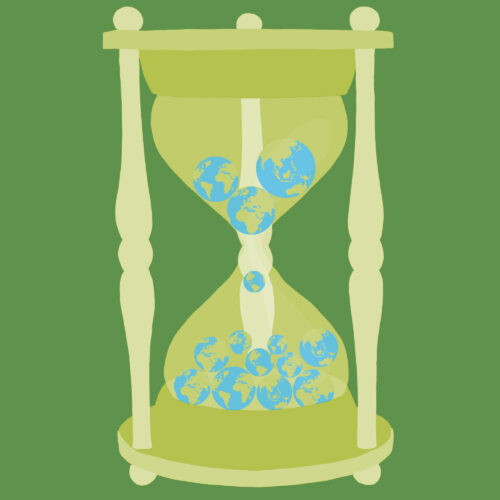
Preservation against waste, quality against water pollution and access against unequal distribution of water on Earth.

Cette liste rouge de l’UICN est une base de données en ligne avec moteur de recherche qui permet d’identifier et de décrire les espèces qui ont le plus besoin de mesures de conservation.

Cette Convention a permis de protéger les espèces sauvages qui étaient menacées d’extinction.

Le message principal de ce rapport est qu’il faut « penser globalement et agir localement ». Ce document a définit pour la première fois le développement durable tel qu’on l’entend aujourd’hui encore.

Le développement durable passe par la lutte contre le réchauffement climatique et la protection de la biodiversité ; ces objectifs ont été abordés en 2012 pour que tous les pays s’unissent pour préserver l’environnement.

Cette organisation non gouvernementale lutte pour la protection de l’environnement de manière non violente et médiatisée.

Le rapport de la GIEC avance comme première cause de cette évolution du climat les émissions mondiales de gaz à effet de serre dues aux activités humaines.

C’est en 1992, que l’Agenda 21 a été adopté c’est-à-dire un programme d’action pour le XXIème siècle qui liste 2500 recommandations en matière d’environnement.

Les critiques ont porté sur le manque d’objectifs chiffrés de réduction des émissions de CO2 et sur le fait que si les pays ne respectent pas ces objectifs d’émission, ils n’auront aucune conséquence.

La désertification, qui est la dégradation des terres dans les zones arides sèches à cause des variations climatiques et aux activités humaines, touche un tiers de la surface de la Terre.
International Geneva: international players for global challenges
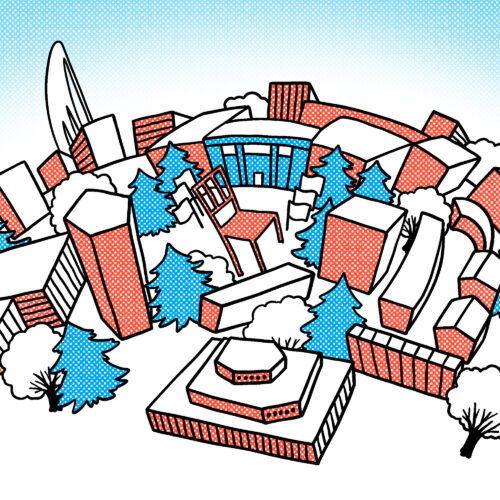
Geneva is considered an international city because it hosts many international organizations, non-governmental organizations, embassies and permanent missions.

There are 35 international organizations based in Geneva and around 250 non-governmental organizations.

Thanks to Genevan H. Dunant and the creation of the International Committee of the Red Cross (ICRC), Geneva has attracted many other organizations (such as the United Nations).

Switzerland’s neutrality is part of the reason many organizations and international representatives like to meet to discuss, adopt treaties or resolve conflicts in Geneva.

This East African country is the last of the 193 UN member states.

WHO means World Health Organization and, as the name implies, it works to ensure that everyone enjoys good health.

The International Telecommunications Union, founded in 1932 and based in Geneva, specializes in communication and information technologies.

This work denounces the fate of the victims of land mines (who because of the explosion of the mine often loose a limb or their life) and also encourages all countries to sign the Convention against the use and production of these weapons (it is for this reason that it is placed in front of the UN).

Switzerland is the only country to have held a popular referendum on the country’s membership to the United Nations. Wanting to keep their neutrality, the Swiss refused several times before agreeing to join.

The logo of the United Nations High Commissioner for Refugees represents its mission to help refugees find a home and a better life in the host country.
Internet, postal services and telecommunications
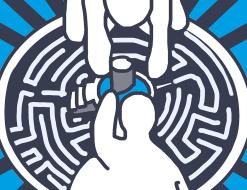
ITU aims to help the world to communicate in three basic areas: Radio communications (eg, satellite orbits), Standardization (eg telephone number codes for each country), and Development (for example, access of information and communication technologies to as many countries as possible).

Agence spécialisée des Nations Unies, elle remplit depuis 1948 un rôle de conseil et liaison, elle fixe des règles pour les échanges de courrier international et apporte, si besoin, une assistance technique pour améliorer la qualité des As a specialized agency of the United Nations, since 1948 it has played an advisory and liaison role, it sets rules for international mail exchanges and, if necessary, provides technical assistance to improve the quality of postal services. services postaux.

The acronym stands for Information and Communication Technologies; it is all the instruments that make it possible to communicate like computer science, audiovisual, internet, multimedia, etc. and in various forms such as video, image, sound, etc. The advent of digital technologies, which allow to transmit or reproduce a document without loss of information, has transformed the world of communication.

It was in 1973 that its inventor, Dr. Martin Cooper, made his first call with a mobile phone.

In 1946, at the request of the US Army, two engineers created the first fully electronic computer named ENIAC (Electronical Numerical Integrator and Computer).

The Morse code was invented by Samuel Morse in 1835 for telegraphy. It is a combination of long and short signals that form words, numbers and punctuation. It has become the official language of communication in the maritime domain (and gave the SOS that we all know now).

CERN computer scientist Tim Berners-Lee looked for a way to allow his colleagues to exchange data quickly, and in 1991 the first website was launched.

It was in Lausanne that the radio Suisse Romande was founded. It was during the inauguration that the real first show took place.

The missions of the EBU, created in 1950, are to promote the values of the public service, work for the future, deliver home events and offer a varied and exclusive content. It is with these goals in mind that a program about a musical competition between all European countries was created.

RSF aims to defend the freedom of the press because “without a free press, no fight can be heard”. This defense includes the struggle to roll back censorship, support for imprisoned and persecuted journalists, financial assistance to journalists and media outlets in difficulty, and action to improve the safety of journalists (especially in conflict zones).
Humanitarian Aid

These three principles mean that assistance is based on non-discrimination, protection against the effects of hostilities and the limitation and ban on certain weapons.

Thanks to H. Dunant and his help on the battlefield at Solferino, the International Committee of the Red Cross was founded in Geneva to help the victims of the war.

A refugee is forced to flee his or her country because of war, persecution, or political opinion and seeks the protection of the host country. A migrant chooses to leave his country and can return whenever he wishes.

This Convention comes to the aid of war victims on the battlefield and marks the beginning of Red Cross action.

These children are abducted and forced to fight in wars. Many of them never went to school, they are very impressionable and do not question orders.

This Office, created in 1991, makes it possible to provide effective humanitarian aid thanks to the division of tasks of each entity (international organizations, NGOs, States…).

Armed conflicts also affect cultural heritage, which is why this shield makes it possible to protect this heritage in the event of wars or natural disasters.

All Red Cross and Red Crescent Societies are grouped together to alleviate people’s suffering and preserve lives, without any discrimination and with respect for dignity.

These weapons, which are buried underground and explode when stepped on, are considered to be the weapons that cause the most casualties because they also affect civilians and can still explode after the war.

Refugees, after having fled their country, are welcomed in these temporary camps and receive help in care, food, administration etc., before finding a solution for their future (a country that can welcome them for example).
Global Health Governance
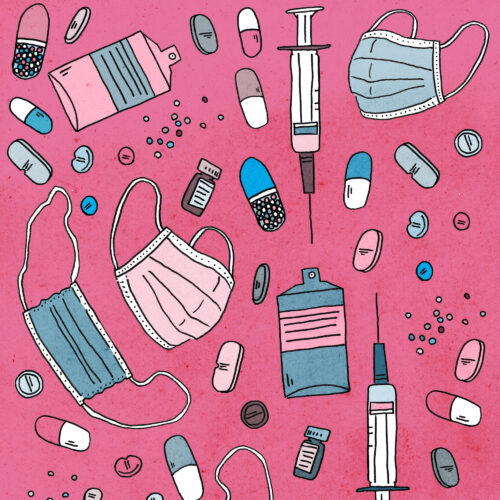
WHO’s mission is to work for health around the world, to bring all people to the highest level of health.

The risks associated with obesity are many, it can cause diabetes, heart disease or hypertension.

Epidemics of cholera (which according to the WHO is an acute diarrhea infection caused by the ingestion of food or water contaminated by a bacterium) affected Europe between 1830 and 1847; which paved the way for cooperation between countries in health matters.

A. Paré made great advances in amputation techniques thanks to his new technique of ligation of the artery instead of burning with a hot iron.

Thanks to his discovery in the field of bacteriology, A. Fleming significantly changed the medical and surgical practice of infections and marked the beginning of the era of antibiotics.

GOARN’s mission is the rapid identification, verification and communication of threats aimed at a coordinated response between several partners to provide effective and timely medical assistance.

Doctors without borders, or MSF’s goal is to provide humanitarian assistance by providing medical relief in several countries around the world, including some in war situations.

The disease is named after the Ebola River near Yambuku (a city in the Democratic Republic of Congo) where the disease first appeared in 1976.

The Regulations are an initiative of several countries to establish an effective global surveillance instrument for the transmission of infectious diseases between countries.

This support for women and children can result in assistance with childbirth or access to vaccines.
Forced Displacement

Ces trois principes signifient que l’aide apportée se base sur la non-discrimination, la protection contre les effets des hostilités et la limitation et interdiction relatives à certaines armes.

Grâce à H. Dunant et à son aide apportée sur le champ de bataille à Solferino, le Comité international de la Croix-Rouge a vu le jour à Genève pour venir en aide aux victimes de la guerre.

Un réfugié est obligé de fuir son pays à cause de la guerre, de persécutions ou encore à cause de ses opinions politiques et il demande la protection du pays d’accueil. Alors qu’un migrant choisit de quitter son pays et peut y retourner quand il le désire.

Cette Convention vient en aide aux victimes de la guerre, sur le champ de bataille et marque le début de l’action de la Croix-Rouge.

Ces enfants sont enlevés et obligés de combattre lors de guerres. Beaucoup d’entre eux ne sont jamais aller à l’école, ils sont très influençables et ne remettent pas en question les ordres.

Ce Bureau créé en 1991 permet d’apporter une aide humanitaire efficace grâce à la répartition des tâches de chaque entité (organisations internationales, ONG, États…).

Les conflits armés touchent aussi le patrimoine culturel, c’est pourquoi ce bouclier permet de protéger ce patrimoine en cas de guerres ou de catastrophes naturelles.

Toutes les sociétés de la Croix-Rouge et du Croissant-Rouge sont regroupées pour alléger les souffrances des populations, préserver des vies, sans aucune discrimination, dans le respect de la dignité.

Ces armes, enfouies sous terre et qui explosent lorsqu’on marche dessus, sont considérées comme des armes provoquant le plus victimes car elles touchent également les civils et peuvent encore exploser après la guerre.

Les réfugiés, après avoir fui leur pays, sont accueillis dans ces camps temporaires et reçoivent une aide en soins, nourriture, administration etc., avant de trouver une solution pour leur futur (un pays qui peut les accueillir par exemple).
Human Rights: equal rights for all
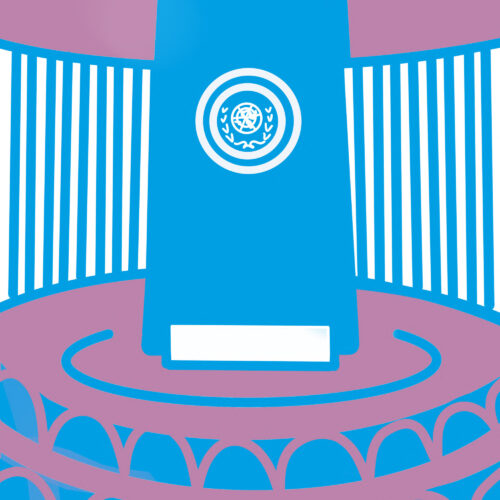
Cette Déclaration a été adoptée en 1948 par l’Assemblée générale des Nations Unies. Elle représente une réelle avancée dans l’histoire de l’humanité car des normes communes et internationales sont fixées pour tous les hommes et tous les pays du monde en matière de droits et libertés fondamentales.

Les droits de l’Homme se composent de tous les droits et de toutes les libertés qui concernent les femmes, les hommes et les enfants de tous les pays du monde mais ne concerne pas le respect de l’environnement.

Depuis 1946, UNICEF s’engage pour la protection des enfants et l’amélioration de leurs conditions de vie.

Depuis 2007, l’Examen Périodique Universel se tient lors du Conseil des droits de l’Homme, organisé à l’ONU par le Haut-Commissariat aux droits de l’Homme. Ce mécanisme permet d’évaluer le respect de ces droits dans tous les pays membres de l’ONU.

Restaurée en 2008 par Miquel Barcelò et financée par l’Espagne (comme cadeau à l’ONUG), son plafond est recouvert de stalactites irrégulières qui évoquent la mer.

L’UNESCO a pour mission de rendre accessible et améliorer la qualité de l’éducation pour tous les Hommes. L’éducation et l’alphabétisation représentent des droits de l’Homme fondamentaux car ils permettent à l’individu et à la société une croissance bénéfique.

Bâtiment historique situé au bord du lac Léman, ancien siège de la Société des Nations, le Palais Wilson accueille en son siège, depuis 1998, le Haut-Commissariat des Nations Unies aux droits de l’Homme.

Aucun droit n’est supérieur à un autre. Ils sont tous équivalents et la violation de chaque droit constitue une offense à la dignité humaine.

L’OMS se base sur l’existence en quantité suffisante des installations des biens et des services, de l’accessibilité physique, économique et de l’information et de la bonne qualité des services en matière de santé.

Il existe des groupes minoritaires dans presque tous les pays du monde; par exemple les tziganes ou encore les roms. Bien qu’ils apportent une richesse culturelle, ils appartiennent souvent aux groupes sociaux les plus défavorisés. C’est pour cette raison qu’ils sont souvent discriminés et exclus de la société dans laquelle ils se trouvent.
Migration

These three principles mean that assistance is based on non-discrimination, protection against the effects of hostilities and the limitation and ban on certain weapons.

Thanks to H. Dunant and his help on the battlefield at Solferino, the International Committee of the Red Cross was founded in Geneva to help the victims of the war.

A refugee is forced to flee his or her country because of war, persecution, or political opinion and seeks the protection of the host country. A migrant chooses to leave his country and can return whenever he wishes.

This Convention comes to the aid of war victims on the battlefield and marks the beginning of Red Cross action.

These children are abducted and forced to fight in wars. Many of them never went to school, they are very impressionable and do not question orders.

This Office, created in 1991, makes it possible to provide effective humanitarian aid thanks to the division of tasks of each entity (international organizations, NGOs, States…).

Armed conflicts also affect cultural heritage, which is why this shield makes it possible to protect this heritage in the event of wars or natural disasters.

All Red Cross and Red Crescent Societies are grouped together to alleviate people’s suffering and preserve lives, without any discrimination and with respect for dignity.

These weapons, which are buried underground and explode when stepped on, are considered to be the weapons that cause the most casualties because they also affect civilians and can still explode after the war.

Refugees, after having fled their country, are welcomed in these temporary camps and receive help in care, food, administration etc., before finding a solution for their future (a country that can welcome them for example).
Peace and the United Nations System
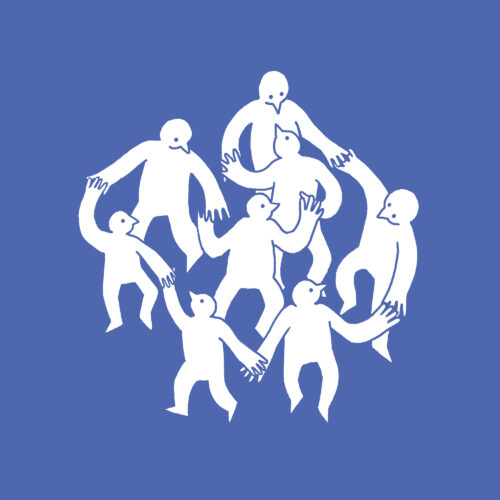
A kiss is a sign of affection but is not recognised as a symbol of peace.

The League of Nations was created after the First World War, it was replaced by the United Nations after the Second World War in 1945.

The “Cold War” represents the confrontation between the communist regimes (USSR) and the Western democracies (United States).

Since 1980, this United Nations program has fostered dialogue among countries and organizations and creates partnerships between them to conduct research on disarmament and security.

The BIP has been awarded the Nobel Peace Prize because its mission is to promote the peaceful resolution of international conflicts by coordinating the activities of the various associations working for peace.

The occupation of Poland by Germany pushed the European powers to declare war on Germany in September 1939.

The Berlin Wall, built in 1961 and separating not only the city into two parts but also the world into two blocks, was destroyed in November 1989. The fall of the Berlin Wall marks the end of the “Cold War” between United States and the USSR.

This UN army is thus named because their helmets are blue, the color of the UN flag.

The sculpture made with a piece of artillery is located on the Place des Nations, facing the Palais des Nations in Geneva. This artwork named Frieden (Peace) was made by the artist from Glarus R. Brandenberg on the occasion of the Conference on Disarmament of 1983.

The Conference on Disarmament allows for the signing of numerous treaties by member countries, such as the one against the use and production of nuclear weapons, biological weapons or land mines.
Population, culture and education: issues addressed in the UN Sustainable Development Goals
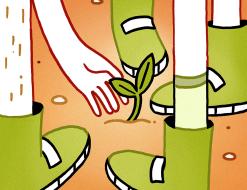
Created in 1945, UNESCO aims to build peace in the minds of men through education, science and culture.

In Switzerland on average women still earn 18% less than men for equal work (with the same level of education), gender equality is not yet achieved in terms of professional compensation.

Due to declining birth rates and increasing life expectancy, the number of older people is increasing; that’s why we’re talking about an aging population. It is estimated that in 2050 the number of older people will exceed that of young people (under 15 years old).

On average the fastest growing population is in lower income countries of Sub-Sahara Africa.

Among the 17 Sustainable Development Goals adopted by the United Nations, number 4 focuses on education everywhere and for all. These Goals are intended to improve the lives of all the people in the world, by addressing different areas such as education, health, environment, etc.

Indeed, Yemen is in the last place of this ranking against Iceland which is in first place. Switzerland, meanwhile, is ranked 8th out of 145 countries.

It is Rwanda that most respects gender parity in Parliament. It is also in this country that, for equal work, men and women earn the same salary.

Intangible heritage, also called living heritage, encompasses the areas of oral traditions and expressions (languages), the performing arts (music, dance, theater), social practices, rituals and festive events, knowledge and practices concerning nature and the universe and traditional craftsmanship.

This Declaration is the first to recognize cultural diversity as a “common heritage of humanity” and to consider its safeguarding as an imperative. That is why the purpose of this Declaration is to deepen our reflections on the values of cultural diversity to learn how to live better together.

UNFPA, based in Nairobi (Kenya), engages in education and projects to implement three broad areas of action: reproductive health, population and development strategies to build capacity in population programs and the promotion of women’s empowerment and gender equality.
Intellectual Property: or how to protect inventions
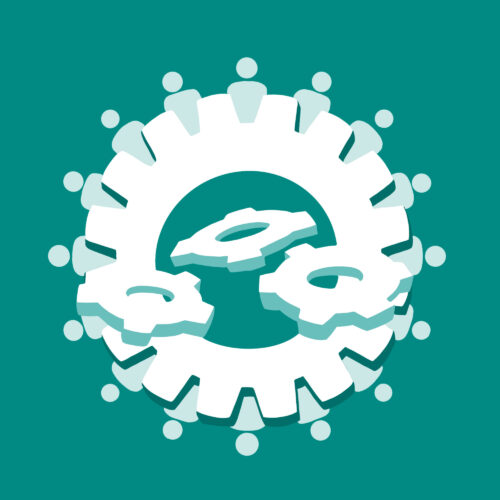
A simple idea does not fulfill the three conditions for obtaining a patent on an invention: to be new, useful and to represent an improvement that would not be obvious to experts in the field.

This symbol means right to copy, that is to say that it indicates that no one can copy the work without the agreement of its author.

Gutenberg invented a typographic process of printing that speeds up the printing output. Large-scale reproduction marks the beginning of a wider diffusion of works and thus a need to protect these works for authors.

This Convention makes it possible to protect literary and artistic works thanks to copyright. These rights consist of two broad categories: the moral right, which represents the personal connection between the author and his work, and the economic rights, which regulate the use of the work and protect the economic interests of the author.

It is not mandatory but if it is placed after the name of the mark, it shows that this mark is registered and protected by the law.

Piracy and plagiarism through the reproduction and use of works without citing sources, and counterfeiting by the production and distribution of imitations of products, without authorization.

From its headquarters in Geneva, WIPO is responsible for promoting the protection of intellectual property worldwide through cooperation among States and administering legal and administrative treaties in this area.

In Switzerland, for example, copyright lasts throughout the life of the author and 70 years after his death.

Discovering something that already exists in nature, such as a new plant variety, is not considered an invention. An invention is, in fact, a product, a method or a new process that brings a new solution to a given practical problem.

Related law refers to intermediaries between the creator and the public. For example, performers of a song, producers of recordings or broadcasting organizations such as television channels or radio stations.
Science and Research: a field which impacts us all
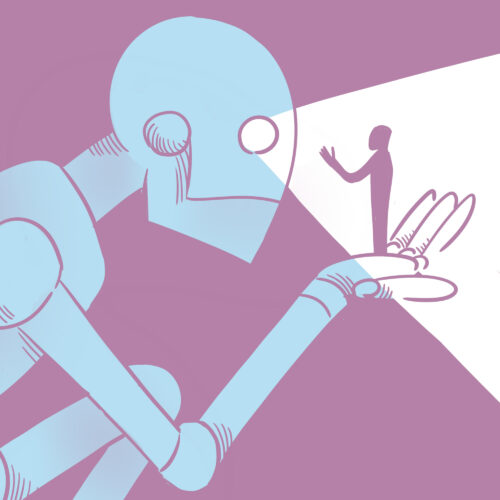
CERN computer scientist Tim Berners-Lee looked for a way to allow his colleagues to exchange data quickly, and in 1991 the first website was launched.

In 1915, A. Einstein discovers one of the most famous equations of science: that space and time are related and that both are relative, which means that they are not absolute and can be deformed. This discovery allowed concrete applications, useful in everyday life such as GPS or the first cathode ray television.

The astronomer, geographer, philosopher and mathematician Eratosthenes, was able, thanks to his research, to calculate the circumference of the Earth and obtain a measurement close to reality.

The ICRC became engaged in the fight against mustard gas (a devastating chemical weapon), which lead in 1925 to the signing of a Protocol (the Geneva Protocol) prohibiting the use of these toxic agents in war.

During the war, Marie Curie set up x-ray machines at the front to identify fractures and locate shrapnel from the wounded.

The bombing partially destroyed both cities and caused the death of thousands of people. This is the first and only time that this nuclear weapon has been used during an armed conflict.

This elementary particle makes it possible to explain the origin of the mass of all the particles of the Universe.

There are five toxic gases: suffocants, incapacitants, vesicants, blood toxins and neurotoxins, each of which causes different effects on humans.

A biological weapon is the use of pathological germs such as viruses, bacteria on a population.

Dolly was reproduced identically after 276 unsuccessful attempts.
Sports: a developmental and economic impact on populations
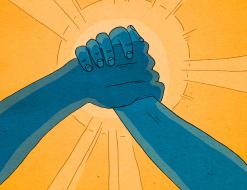
By helping governments, NGOs and experts and through all its activities, UNESCO wants to promote the beneficial action of sports programs on culture, social development and peace between peoples.

Every four years the games were held in Olympia, Greece. These games represented a period of intense competitions during which athletes competed to win the olive wreath.

Lausanne is considered the Olympic capital because the seats of the International Olympic Committee and the Olympic Museum are there thanks to Pierre de Coubertin, a staunch defender of sport.

The ancient Olympic Games were part of a religious festival of worship of Zeus, the father of Greek gods and goddesses.

The Olympic Games are held every two years in different host cities which are chosen by the International Olympic Committee according to various criteria.

“La Soule” is a collective sport practiced mainly in France where you have to score goals. The difference with football that we know today is that at that time all blows were allowed between the players.

The oval ball sport owes its name to the city named Rugby, where in 1823 a football player took the ball in his hand and to back away with the ball; this gave birth to rugby.

Because of the war raging in France and thanks to its neutrality, Switzerland, and more particularly Lausanne, became host to the International Olympic Committee.

Tennis, football and rugby are English while handball is German.

Founded on 22 September 1989 as a non-profit organisation, the IPC is based in Bonn, Germany and aims to develop sports opportunities for all people with an impairment from the beginner to elite level. The vision of the IPC is ‘To enable Para athletes to achieve sporting excellence and inspire and excite the world.’
Transport: to facilitate human and commercial flows in a world in motion
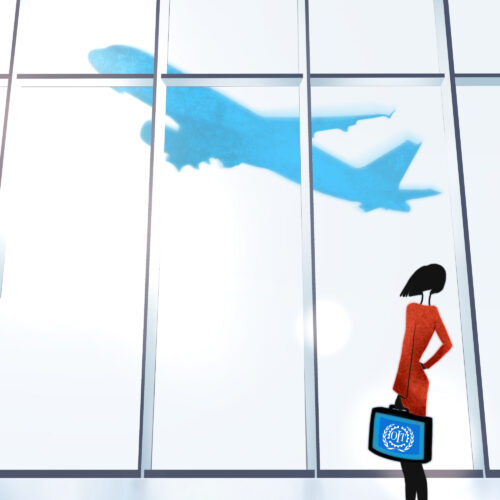
Soft mobility not only promotes CO2-free and noise-free travel, but also contributes to cleaner air and boosts public health.

Thanks to this discovery and various technical improvements, the steam engine will become one of the main technical advance of the industrial revolution and transport.

Founded in 1948 in Geneva, IRU represents the entire road profession around the world. It improves the performance of road transport with regard to safety and the environment while ensuring the mobility of people and goods.

Significant technical progress has made it possible to fly further and make this the safest means of transport in the world. One of the turning points was mass transit with the launch of the Boeing 747 in 1969 because it held the record for the number of passengers on board.

Eurocontrol was established in 1963 to control international flights in airspace. Switzerland joined in 1992.

This project “of the future” uses renewable energy (the sun) to fly a plane. This is a good example of sustainable development because it does not pollute and does not use fossil fuels.

IATA aims to promote the development of air transport by coordinating international standards and ensuring passenger and flight safety.

Based in London, on of the main tasks of the International Maritime Organization (IMO) is to strengthen maritime safety at the international level, for example by combating the risks of marine pollution.

The International Maritime Organization has issued recommendations to governments regarding the prevention and suppression of acts of piracy and armed robbery against ships. A piracy observation center has also been created to fight against pirates.

The burning of petrol (main fuel for cars) causes greenhouse gases, including CO2; which contributes to global warming and therefore to pollution.
17 Goals to Transform our World
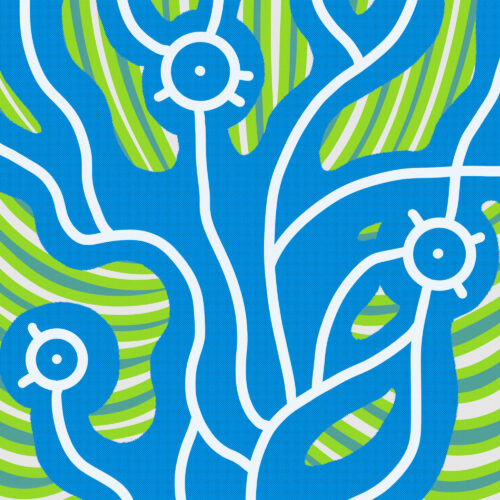
In order to achieve the Sustainable Development Goals, participation from all countries in the world is needed, regardless of their wealth. However, the measures to be taken are not the same for everyone, as each country sets up solutions adapted to their own reality.

There are 17 Sustainable Development Goals that aim to transform our world into a place where everyone can live with dignity.

To be sustainable, development must be socially equitable, ecologically tolerable and economically efficient.

The Sustainable Development Goals were adopted in 2015, as part of an action plan to be completed by 2030.

Responsible consumption takes into account the criteria of sustainable development. It must be respectful of the environment, beneficial to the economy and positive for society. Having devices repaired that no longer work, rather than buying new ones, reduces the amount of resources we use, while supporting sustainable jobs. Similarly, we can donate objects that we no longer use instead of throwing them away so some else can benefit from them.

The Sustainable Development Goals aim to provide every human being with a dignified life, safe from poverty. Thus cheap labor goes against these objectives and is not part of it. On the contrary, the Goals promote decent working conditions that allow workers to earn enough money to support themselves and their families properly.

The development aid provided by Switzerland in 2015 was about 92 cents per citizen per day. It’s less than the price of a croissant.

Gender equality is based on the idea that men and women are equal. Thus, no group is superior to the other and that women and men have the same rights. According to the principle of gender equality, men and women should receive the same pay for equal work with equal skills and the same opportunities.

1.2 billion people, or 1 in 5 people worldwide, still do not have access to electricity. The majority of them are concentrated in a dozen countries in Africa and Asia.

With 63.8% of women in the Chamber of Deputies, Rwanda is at the top of the world rankings. In Switzerland, the proportion of women is 15% in the Council of States and 33% in the National Council (2018).
